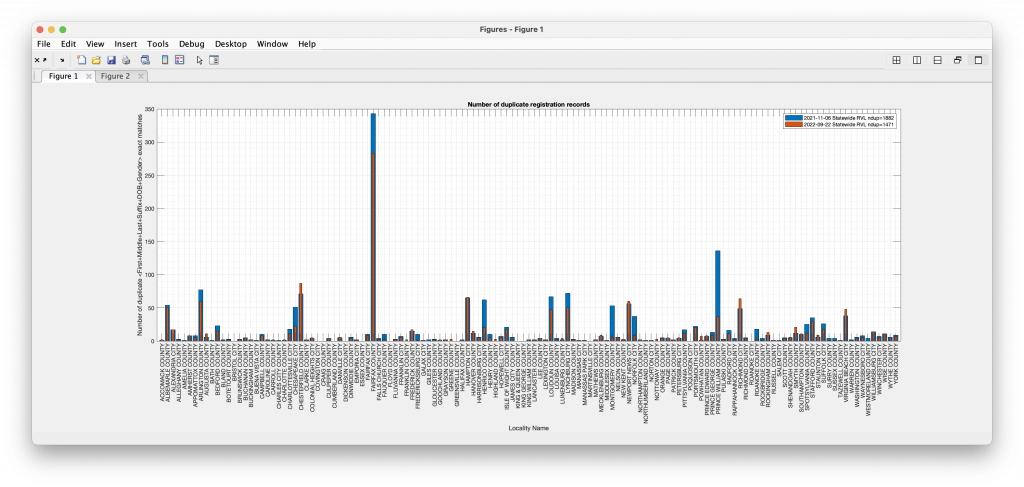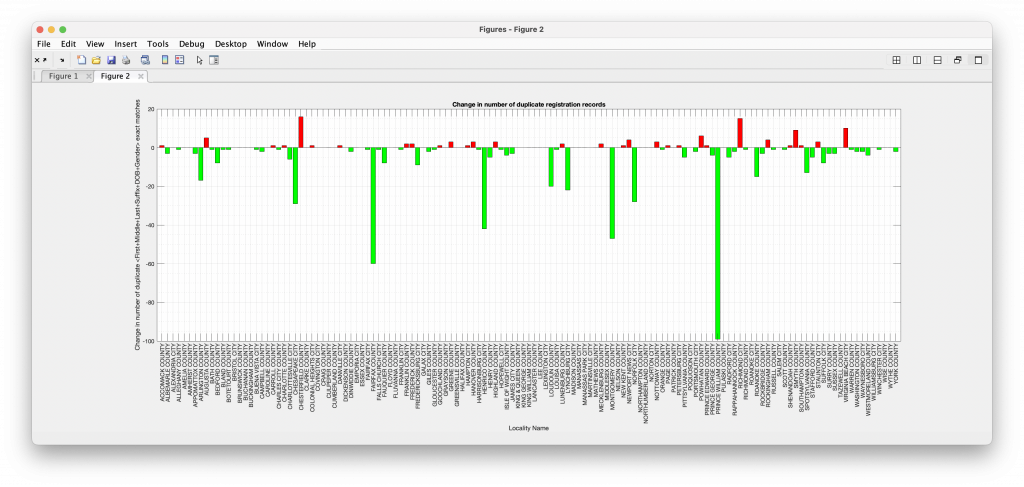Update 10-17-2022: There has been an issue with the VERIS system (the database that runs behind the scenes at the VA department of elections) where updates to the DAL files have not progressed since 10/14. On 10/17 there was a published change to the data files but the report generated was incomplete and cutoff halfway through its listing of CARROL COUNTY data. I had a phone conversation on 10/17 with ELECT and they are aware of the issue and working to correct it. Also I have included a new gallery at the bottom of the page of all of the individual localities or precincts that are automatically flagged as having issues of concern. Issues detected include any number of “vanishing” voters as defined below, “On Machine” ballot counts that decrease day-to-day, “Marked” OR “Pre-Processed” counts that decrease day-to-day, etc.
Update 10-18-2022: The publication of the DAL files has resumed. I have queries in to the department of elections as to the exact cause of the issues and will update accordingly as I find out more information.
Below is the current set of statistics from the 2022 VA General Election Daily Absentee List (DAL) file records. There are two plots below representing the same data, one plot with a linear y-axis and the other with a logarithmic y-axis. The x-axis is the date that each DAL file processed was archived and pulled from the Dept of Elections (ELECT) servers. Solid traces are directly extracted data from the DAL files. Dashed traces are computed metrics such as the number of “vanished” voters detected (described below). Red datapoints are placed on traces that exhibit questionable behavior, for example if the number of “approved” and “countable” ballots ever decreases, etc. Vertical dotted lines indicate important dates.
There are two very important fields in the DAL file that we want to pay attention to here: the APP_STATUS field, and the BALLOT_STATUS field.
DAL records with APP_STATUS = “Approved” and BALLOT_STATUS = “Issued” indicate a ballot that has been mailed to a voter.
DAL records with APP_STATUS = “Approved” and BALLOT_STATUS = “Marked” indicate a mail-in ballot that has been mailed to a voter, and then subsequently returned.
DAL records with APP_STATUS = “Approved” and BALLOT_STATUS = “Pre-Processed” indicate a mail-in ballot that has been mailed to a voter, returned and the ballot envelope has been opened and the ballot processed.
DAL records with APP_STATUS = “Approved” and BALLOT_STATUS = “On Machine” indicate a ballot record from a voter who physically walked into an early voting site and cast their vote on a tabulator machine.
DAL records with APP_STATUS = “Approved” and BALLOT_STATUS = “FWAB” indicate a Federal Worker Absentee Ballot (FWAB) mail-in ballot that has been received.
The combination of all ballots that have APP_STATUS=Approved and BALLOT_STATUS = “Marked” | “Pre-Processed” | “On Machine” | “FWAB” we term as “Countable” ballots.
I’ve computed the number of countable records that have an invalid BALLOT_RECIEPT_DATE or an invalid APP_RECIEPT_DATE. (For example if the BALLOT_RECIEPT_DATE is before the start of early voting, etc.)
I am also attempting to detect the number of duplicate voter IDs in a “countable” (as described above) state, if any, for each DAL file.
Additionally, I’ve computed and plotted the number of “Vanished” voters seen as we process the DAL files in chronological order. As each publication of the the DAL file is intended to capture information on all of the absentee ballots to date during an election, we would expect that once a unique voter ID becomes a record in the DAL file, that all subsequent DAL files should have an entry for that ID, regardless of its status. However, we know there are multiple instances where a voter ID will show up in the DAL record on a given date, and then be completely missing from a future DAL file.
Upon asking the department of elections for clarification as to how this can occur, their answer given was that if the voter has their registration cancelled for any reason, they are also removed from the DAL file. This holds true, even if live ballots had been issued for that voter, or if the voters vote has already been fed into a tabulator. This means that there is NO ACCOUNTING for these ballots in the DAL record. Note that the department of elections also does the same thing with the Voter History List (VHL) and the List of Those Who Voted (LTWV) data files. This is apparently standard operating procedure for the VERIS database(s) at ELECT, and (I quote) “… nothing unusual …” or to be concerned about as far as the department of elections is concerned. I vehemently disagree, and think that removing these records from the DAL while the election is ongoing is extremely problematic, to put it politely.
I will continue to update these plots as the election progresses. as more data comes in I will also be publishing these types of graphs for selected localities and precincts.


All of the latest plots for every locality and precinct as well as the corresponding underlying CSV data files will be updated daily, and you can download them here.
The semilog versions of the plots for all localities or precincts that appear in the DAL data that have flagged issues of concern are shown in the gallery below. The image carousel below might take a moment to load, btw.



